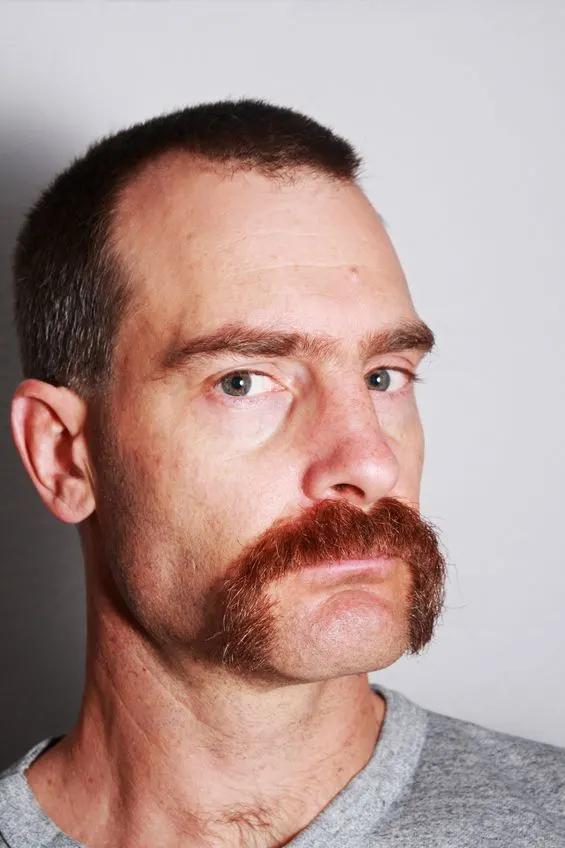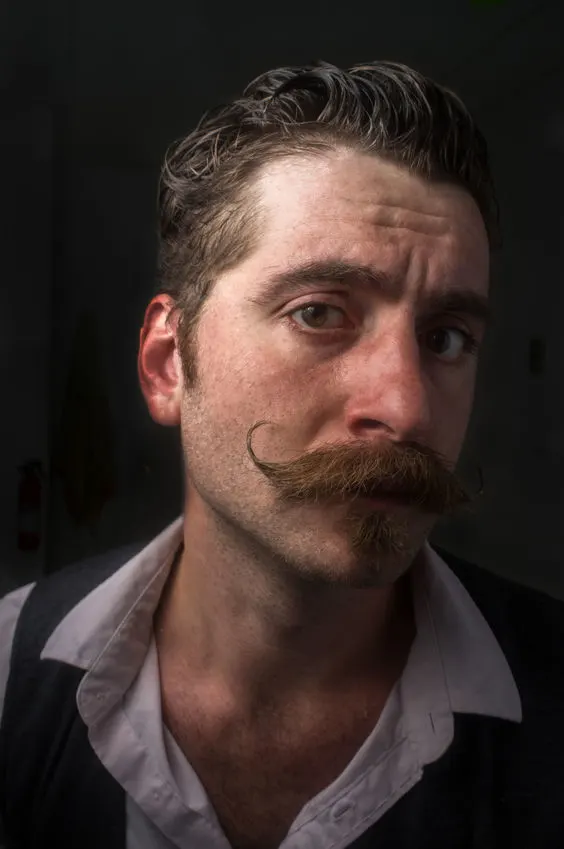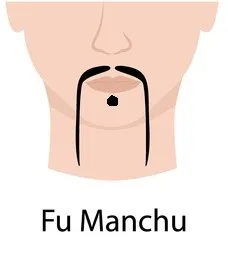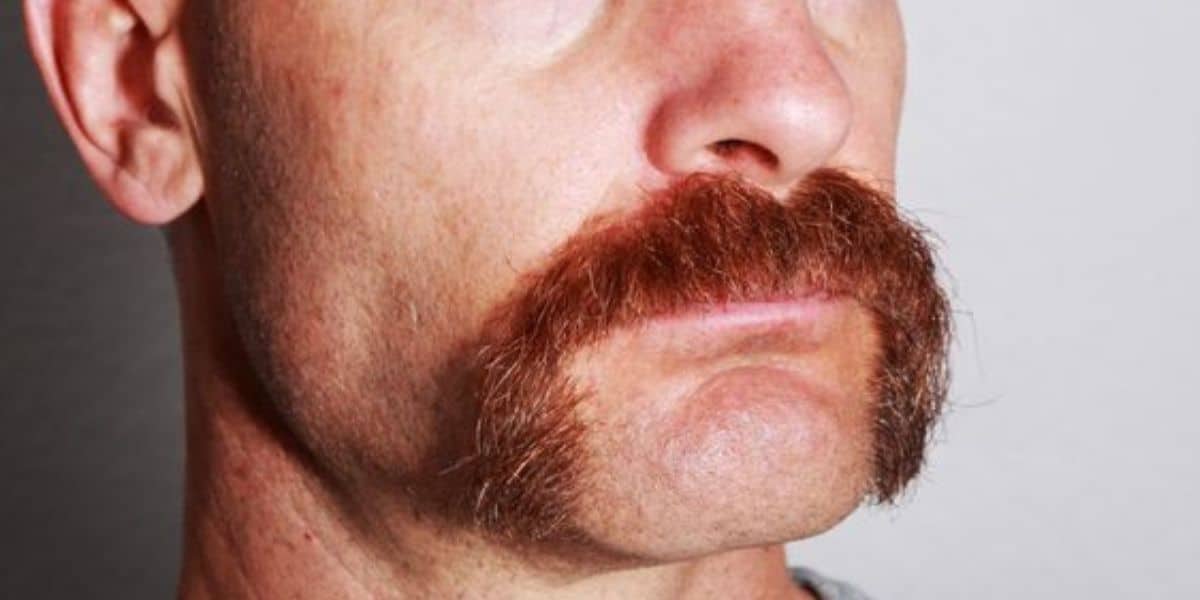It’s the subtleties that make all the difference. The simple addition of a soul patch can add a layer of sophistication to a mustache like few other tufts of facial hair can.
You’re about to learn everything you need to know about the mustache and soul patch combination – what it is, what it looks like, and what you can do with it.
Let’s get to it.
What Is The “Mustache With Soul Patch”?
The mustache and soul patch combination is where you’ve got a strip of hair immediately above the upper lip (a mustache) and a small tuft immediately below the lower lip (a soul patch).

Image From Deposit Photos
Strictly speaking, for the style to accurately be labeled a “mustache with soul patch”, this should be the only facial hair present.
Anything more and it would be more appropriate to call it by a different name.
Let’s briefly talk through each component separately.
There are many different forms of mustaches – we’ll go through several of them a bit later on. You’ve got Handlebars, Horseshoes, Fu Manchus, and so on.
Mustaches are easy to recognize and hard to miss.
The soul patch is a little more confusing to some. It’s important to understand that a soul patch is not a goatee.
While a “goatee” refers to a tuft of hair on the chin itself, a “soul patch” is a tiny patch of hair immediately below the lower lip.
What Is A Mustache With A Soul Patch Called?
A mustache with a soul patch is simply called a “mustache” or a “mustache with soul patch”. As the soul patch is a minor embellishment, it’s rarely enough to change the name of the mustache style as a whole.
Most people would simply call it a “mustache”, with the soul patch either ignored or considered an add-on.
One thing that it shouldn’t be called, is a goatee style.
While a mustache combined with a tuft of hair on the chin itself could be called a “disconnected goatee”, merely having a soul patch isn’t enough for it to be called this.
This is really the only important distinction that needs to be made when it comes to this matter. Don’t get too bogged down with the details.
The other way of labeling it would be by referring to the mustache by its specific name. For example, the “horseshoe mustache with a soul patch”, or a “walrus mustache with a soul patch”.
I’ll be delving into a few of these later on.
Grow The Mustache With Or Without The Soul Patch?
Mustaches are more commonly grown with the soul patch, as it adds a sophisticated flair and prevents the mustache from becoming too overbearing. Growing the mustache without the soul patch does add additional prominence to the mustache itself, however.
Soul patches have an artistic edge to them, growing prominence during the era of the beatnik poets in the 1940s and 50s.
Since then, the lone soul patch has definitely grown out of favor. It’s very rare to see a soul patch on its own these days.
However, the combination of a soul patch with a mustache is still a facial hairstyle that’s alive and well. It carries a similar sophisticated flair to that which the lone soul patch had several decades ago.
Men who are drawn to this aesthetic, or simply don’t want to give too much prominence to the mustache itself, would do well to keep the soul patch.
It’s easy to maintain and softens the appearance of the mustache, making it look more like a beard style and less like a pure mustache style.
However, men who prefer to be known as purist mustachios may not want any facial hair other than the strip immediately above their upper lip.

Image From 123RF
They’d be better off shaving off the soul patch to ensure that all eyes are on the mustache and nowhere else.
Centre stage without any competition from facial hair elsewhere.
5 Mustache With Soul Patch Styles
Here are some mustache styles that are commonly combined with a soul patch for added effect.
Horseshoe Mustache With Soul Patch
The horseshoe mustache and soul patch are a common combination. It consists of a mustache in the shape of an inverted ‘U’ around the mouth, as well as a small tuft of hair beneath the lower lip.

Image From Deposit Photos
It’s named as such because the mustache does very much resemble a horseshoe. The edges shouldn’t extend beyond the edge of the jawline.
The mustache is undoubtedly the most prominent feature of the combination – it’s hard to ignore but isn’t as common of a style as it once was.
While it became strongly associated with cowboy culture, it has remained a staple of “tough guy” mustaches and biker gang facial hair.
It oozes a sense of rebellion and has an immediately eye-catching aesthetic.
Adding a soul patch to a horseshoe mustache is a great way to prevent the mustache from becoming too overbearing.
It adds a sense of balance to the horseshoe mustache, softening it and preventing it from becoming the sole focus of attention.
Overall, the style is relatively high maintenance. Although it’s reasonable to keep some light stubble on the cheeks and chin, usually, you’ll need to shave it regularly to ensure it doesn’t blend into the mustache/soul patch itself.
In addition, the edges of the horseshoe will need to be trimmed and defined to make the shape itself obvious.
Handlebar Mustache With Soul Patch
The handlebar mustache with a soul patch is a style where a soul patch is combined with a curled mustache resembling the handlebars of a bicycle. It’s arguably the most common variation of the mustache and soul patch combination.

Image From 123RF
Handlebar mustaches are globally popular among men looking to truly establish themselves as thoroughly mustachioed.
The edges are curled upward. In order to achieve this, you’ll need enough length, as well as some styling product (eg. mustache wax) to keep it in place.
But why is the handlebar mustache so commonly combined with a soul patch?
It’s unclear. But there’s just something very appealing about adding a little patch of hair beneath the lip directly beneath the center of the “handles” of the handlebar mustache.
It adds a great sense of symmetry.
Chevron Mustache With Soul Patch
The chevron mustache and soul patch is a style combination. It consists of a mustache that is full and robust, yet doesn’t extend down beyond the border of the upper lip. The mustache is embellished and complimented by a soul patch beneath the lower lip.

Image From Deposit Photos
The chevron is typically more popular among older gentlemen. It has a distinctively authoritative edge to it.
It has a fullness to it as it’s allowed to grow thick and wide across the upper lip. The most important feature is that the hair doesn’t creep over the upper lip as a Walrus mustache might.
Regular snips with a little pair of mustache scissors are a necessity.
Keeping the lips clear of the hair doesn’t just have a neat and tidy aesthetic to it. It’s also practical – mustache hair in the mouth while eating is never a pleasant experience.
The corners of the mustache aren’t allowed to extend too far beyond the corners of the mouth on either side. It’s important to differentiate it from the Horseshoe.
Adding the soul patch to the chevron is a great way of softening its appearance and preventing the chevron from taking over the entire face.
As it’s such a full and dominating style, balancing things out with a small patch of hair beneath the lower lip is a good way to go.
Pencil Mustache With Soul Patch
The pencil mustache with a soul patch is a classic combination. It consists of a very thin strip of hair above the upper lip and a small patch of hair beneath the lower lip.

Image From Shutterstock
The pencil mustache itself can vary in width, but is usually “pencil-thin”. It can also be “single” or “double”.
A “single” pencil mustache is a continuous strip along the edge of the upper lip. A “double” is where there is a small gap in the middle.
The “double” was very popular during the Golden Age of Hollywood, sported by revered actors on the silver screen.
It immediately conjures up thoughts of black-tie, fine dining, and expensive cocktails.
While it’s predominantly considered a classic mustache style and isn’t anywhere near as popular as the Handlebar in the modern era, for instance, it still crops up.
Combining the pencil mustache with a soul patch is a good way to “flesh out” the facial hairstyle. The pencil mustache can look quite bare or incomplete, especially when it’s very thin.
Adding a soul patch can make the style as a whole more obvious and prominent.
Fu Manchu Mustache With Soul Patch
The Fu Manchu and soul patch is a combination consisting of two long tendrils originating from the corners of the upper lip and a small tuft of hair beneath the lower lip.

Image From Deposit Photos
Although they’re commonly confused, the main difference between a Fu Manchu and a Horseshoe is that the center above the upper lip is shaved with the Fu Manchu.
The long tendrils actually originate from the sides or the corners above the upper lip.
With the Fu Manchu, the tendrils usually extend beyond the jawline and chin.
While the Fu Manchu is rarely spotted in Western culture, it has attained significant fame thanks to its association with villainous characters in movies.
The soul patch is rarely combined with the Fu Manchu, although it can be found.
The Fu Manchu mustache is more likely to be combined with a long goatee (i.e hair on the tip of the chin) as opposed to a simple soul patch.
Conclusion
While the lone mustache has its raving fans as well as its detractors in the modern era, combinations such as these are hard to dislike.
The mustache and soul patch may have many different variations, but overall, adding a soul patch is always a great way to add balance and depth to a lone mustache.
Enjoy.
Ready Sleek founder. Obsessed with casual style and the minimalist approach to building a highly functional wardrobe. Also a fan of classic, vintage hairstyles.







